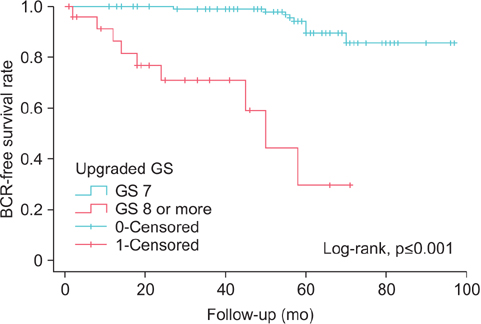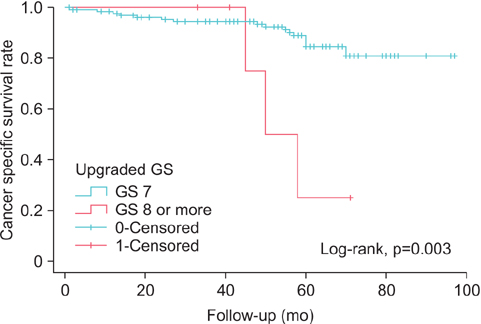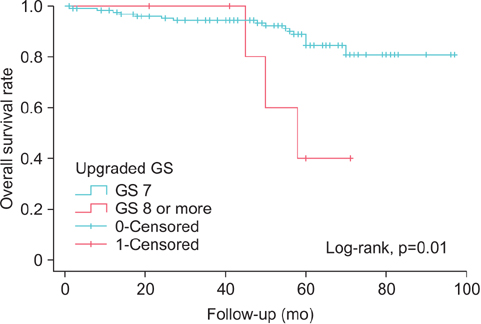Investig Clin Urol.
2017 Mar;58(2):90-97. 10.4111/icu.2017.58.2.90.
Prostate-specific antigen 10–20 ng/mL: A predictor of degree of upgrading to ≥8 among patients with biopsy Gleason score 6
- Affiliations
-
- 1Department of Urology and Urological Science Institute, Yonsei University College of Medicine, Seoul, Korea. khrha@yuhs.ac
- 2Department of Urology, Tanta University Medical School, Tanta, Egypt.
- KMID: 2368473
- DOI: http://doi.org/10.4111/icu.2017.58.2.90
Abstract
- PURPOSE
This study aimed to identify the predictors of upgrading and degree of upgrading among patients who have initial Gleason score (GS) 6 treated with robot-assisted radical prostatectomy (RARP).
MATERIALS AND METHODS
A retrospective review of the data of 359 men with an initial biopsy GS 6, localized prostate cancer who underwent RARP between July 2005 to June 2010 was performed. They were grouped into group 1 (nonupgrade) and group 2 (upgraded) based on their prostatectomy specimen GS. Logistic regression analysis of studied cases identified significant predictors of upgrading and the degree of upgrading after RARP.
RESULTS
The mean age and prostate-specific antigen (PSA) was 63±7.5 years, 8.9±8.77 ng/mL, respectively. Median follow-up was 59 months (interquartile range, 47-70 months). On multivariable analysis, age, PSA, PSA density and ≥2 cores positive were predictors of upgrading with (odds ratio [OR], 1.03; 95% confidence interval [CI], 1.01-1.06; p=0.003; OR, 1.006; 95% CI, 1.01-1.11; p=0.018; OR, 0.65; 95% CI, 0.43-0.98, p=0.04), respectively. On subanalysis, only PSA level of 10-20 ng/mL is associated with upgrading into GS ≥8. They also had lower biochemical recurrence free survival, cancer specific survival, and overall survival (p≤0.001, p=0.003, and p=0.01, respectively).
CONCLUSIONS
Gleason score 6 patients with PSA (10-20 ng/mL) have an increased risk of upgrading to pathologic GS (≥8), subsequently poorer oncological outcome thus require a stricter follow-up. These patients should be carefully counseled in making an optimal treatment decision.
MeSH Terms
Figure
Reference
-
1. Mohler J, Bahnson RR, Boston B, Busby JE, D'Amico A, Eastham JA, et al. NCCN clinical practice guidelines in oncology: prostate cancer. J Natl Compr Canc Netw. 2010; 8:162–200.2. Albertsen PC, Hanley JA, Gleason DF, Barry MJ. Competing risk analysis of men aged 55 to 74 years at diagnosis managed conservatively for clinically localized prostate cancer. JAMA. 1998; 280:975–980.3. Cohen MS, Hanley RS, Kurteva T, Ruthazer R, Silverman ML, Sorcini A, et al. Comparing the Gleason prostate biopsy and Gleason prostatectomy grading system: the Lahey Clinic Medical Center experience and an international meta-analysis. Eur Urol. 2008; 54:371–381.4. Lim SK, Kim KH, Shin TY, Chung BH, Hong SJ, Choi YD, et al. Yonsei criteria: a new protocol for active surveillance in the era of robotic and local ablative surgeries. Clin Genitourin Cancer. 2013; 11:501–507.5. Boorjian SA, Karnes RJ, Crispen PL, Rangel LJ, Bergstralh EJ, Sebo TJ, et al. The impact of discordance between biopsy and pathological Gleason scores on survival after radical prostatectomy. J Urol. 2009; 181:95–104.6. Corcoran NM, Hong MK, Casey RG, Hurtado-Coll A, Peters J, Harewood L, et al. Upgrade in Gleason score between prostate biopsies and pathology following radical prostatectomy significantly impacts upon the risk of biochemical recurrence. BJU Int. 2011; 108(8 Pt 2):E202–E210.7. Menon M, Bhandari M, Gupta N, Lane Z, Peabody JO, Rogers CG, et al. Biochemical recurrence following robot-assisted radical prostatectomy: analysis of 1384 patients with a median 5-year follow-up. Eur Urol. 2010; 58:838–846.8. Hwang I, Lim D, Jeong YB, Park SC, Noh JH, Kwon DD, et al. Upgrading and upstaging of low-risk prostate cancer among Korean patients: a multicenter study. Asian J Androl. 2015; 17:811–814.9. Sarici H, Telli O, Yigitbasi O, Ekici M, Ozgur BC, Yuceturk CN, et al. Predictors of Gleason score upgrading in patients with prostate biopsy Gleason score ≤6. Can Urol Assoc J. 2014; 8:E342–E346.10. Kim KH, Lim SK, Shin TY, Lee JY, Chung BH, Rha KH, et al. Upgrading of Gleason score and prostate volume: a clinicopathological analysis. BJU Int. 2013; 111:1310–1316.11. Rha KH. Robot-assisted laparoscopic radical prostatectomy. Korean J Urol. 2009; 50:97–104.12. Cagiannos I, Karakiewicz P, Eastham JA, Ohori M, Rabbani F, Gerigk C, et al. A preoperative nomogram identifying decreased risk of positive pelvic lymph nodes in patients with prostate cancer. J Urol. 2003; 170:1798–1803.13. King CR, McNeal JE, Gill H, Presti JC Jr. Extended prostate biopsy scheme improves reliability of Gleason grading: implications for radiotherapy patients. Int J Radiat Oncol Biol Phys. 2004; 59:386–391.14. Cookson MS, Aus G, Burnett AL, Canby-Hagino ED, D'Amico AV, Dmochowski RR, et al. Variation in the definition of biochemical recurrence in patients treated for localized prostate cancer: the American Urological Association Prostate Guidelines for Localized Prostate Cancer Update Panel report and recommendations for a standard in the reporting of surgical outcomes. J Urol. 2007; 177:540–545.15. Carlsson S, Jäderling F, Wallerstedt A, Nyberg T, Stranne J, Thorsteinsdottir T, et al. Oncological and functional outcomes 1 year after radical prostatectomy for very-low-risk prostate cancer: results from the prospective LAPPRO trial. BJU Int. 2016; 118:205–212.16. Dong F, Jones JS, Stephenson AJ, Magi-Galluzzi C, Reuther AM, Klein EA. Prostate cancer volume at biopsy predicts clinically significant upgrading. J Urol. 2008; 179:896–900.17. Hong SK, Han BK, Lee ST, Kim SS, Min KE, Jeong SJ, et al. Prediction of Gleason score upgrading in low-risk prostate cancers diagnosed via multi (> or = 12)-core prostate biopsy. World J Urol. 2009; 27:271–276.18. Colleselli D, Pelzer AE, Steiner E, Ongarello S, Schaefer G, Bartsch G, et al. Upgrading of Gleason score 6 prostate cancers on biopsy after prostatectomy in the low and intermediate tPSA range. Prostate Cancer Prostatic Dis. 2010; 13:182–185.19. Ellis CL, Walsh PC, Partin AW, Epstein JI. Multiple cores of Gleason score 6 correlate with favourable findings at radical prostatectomy. BJU Int. 2013; 111:E306–E309.20. Kim SJ, Park CM, Seong KT, Kim SY, Kim HK, Park JY. pT3 predictive factors in patients with a Gleason score of 6 in prostate biopsies. Korean J Urol. 2011; 52:598–602.21. Serkin FB, Soderdahl DW, Cullen J, Chen Y, Hernandez J. Patient risk stratification using Gleason score concordance and upgrading among men with prostate biopsy Gleason score 6 or 7. Urol Oncol. 2010; 28:302–307.22. Jin BS, Kang SH, Kim DY, Oh HG, Kim CI, Moon GH, et al. Pathological upgrading in prostate cancer patients eligible for active surveillance: Does prostate-specific antigen density matter? Korean J Urol. 2015; 56:624–629.23. Turley RS, Hamilton RJ, Terris MK, Kane CJ, Aronson WJ, Presti JC Jr, et al. Small transrectal ultrasound volume predicts clinically significant Gleason score upgrading after radical prostatectomy: results from the SEARCH database. J Urol. 2008; 179:523–527.24. Epstein JI, Feng Z, Trock BJ, Pierorazio PM. Upgrading and downgrading of prostate cancer from biopsy to radical prostatectomy: incidence and predictive factors using the modified Gleason grading system and factoring in tertiary grades. Eur Urol. 2012; 61:1019–1024.25. Caster JM, Falchook AD, Hendrix LH, Chen RC. Risk of pathologic upgrading or locally advanced disease in early prostate cancer patients based on biopsy Gleason score and PSA: a population-based study of modern patients. Int J Radiat Oncol Biol Phys. 2015; 92:244–251.26. Badani KK, Kaul S, Menon M. Evolution of robotic radical prostatectomy: assessment after 2766 procedures. Cancer. 2007; 110:1951–1958.27. Müntener M, Epstein JI, Hernandez DJ, Gonzalgo ML, Mangold L, Humphreys E, et al. Prognostic significance of Gleason score discrepancies between needle biopsy and radical prostatectomy. Eur Urol. 2008; 53:767–775.
- Full Text Links
- Actions
-
Cited
- CITED
-
- Close
- Share
- Similar articles
-
- Is it Appropriate to Lower the Prostate Specific Antigen Cut-off Value to 2.5 ng/ml for Prostate Biopsy in Korean?
- Predictors of Gleason Score Upgrading after Radical Prostatectomy in Low-Risk Prostate Cancer
- Pathological upgrading in prostate cancer patients eligible for active surveillance: Does prostate-specific antigen density matter?
- Comparison of Pathological and Biochemical Outcomes after Radical Prostatectomy in Korean Patients with Serum PSA Ranges
- The Gleason Score and the Change of Serum PSA after Maximum Androgen Blocking in Patients with Metastatic Prostate Cancer




